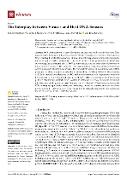The Interplay between Viruses and Host DNA Sensors

Autor
Datum vydání
2022Publikováno v
VirusesRočník / Číslo vydání
14 (4)ISBN / ISSN
ISSN: 1999-4915Metadata
Zobrazit celý záznamKolekce
Tato publikace má vydavatelskou verzi s DOI 10.3390/v14040666
Abstrakt
DNA virus infections are often lifelong and can cause serious diseases in their hosts. Their recognition by the sensors of the innate immune system represents the front line of host defence. Understanding the molecular mechanisms of innate immunity responses is an important prerequisite for the design of effective antivirotics. This review focuses on the present state of knowledge surrounding the mechanisms of viral DNA genome sensing and the main induced pathways of innate immunity responses. The studies that have been performed to date indicate that herpesviruses, adenoviruses, and polyomaviruses are sensed by various DNA sensors. In non-immune cells, STING pathways have been shown to be activated by cGAS, IFI16, DDX41, or DNA-PK. The activation of TLR9 has mainly been described in pDCs and in other immune cells. Importantly, studies on herpesviruses have unveiled novel participants (BRCA1, H2B, or DNA-PK) in the IFI16 sensing pathway. Polyomavirus studies have revealed that, in addition to viral DNA, micronuclei are released into the cytosol due to genotoxic stress. Papillomaviruses, HBV, and HIV have been shown to evade DNA sensing by sophisticated intracellular trafficking, unique cell tropism, and viral or cellular protein actions that prevent or block DNA sensing. Further research is required to fully understand the interplay between viruses and DNA sensors.
Klíčová slova
DNA sensing, innate immunity, DNA viruses, IFN, inflammasome, cGAS, IFI16, p204, Ifi-204, STING, TLR9
Trvalý odkaz
https://hdl.handle.net/20.500.14178/1902Licence
Licence pro užití plného textu výsledku: Creative Commons Uveďte původ 4.0 International







